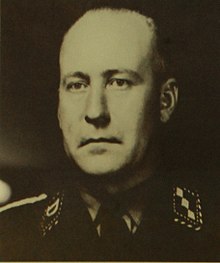Max Koegel
Otto Max Koegel (born October 16, 1895 in Füssen , † June 26, 1946 in Schwabach ) was a German SS-Obersturmbannführer and camp commandant of the Majdanek concentration camp , the Ravensbrück concentration camp and the Flossenbürg concentration camp .
Early years
Max Koegel, the fourth son of a Catholic carpenter, became an orphan at the age of twelve. After completing primary school, he completed an apprenticeship as a shepherd and then trained as a mountain guide. From August 1914, he then served as a volunteer in a Bavarian infantry unit during the First World War . Wounded several times, including in the Battle of Verdun , he made it to the rank of private and received the Iron Cross, second class. After the war he worked first as a customs clerk, later as owner of a souvenir shop and then as a sales representative. Koegel was married twice; one son died of measles in 1929 at the age of eight. During the time of the Weimar Republic he became a member of the nationalist Bund Oberland , the Völkischer Bund and, from October 1931, the SA .
Koegel joined the NSDAP on May 2, 1932 ( membership number 1,179,781) and switched from the SA to the SS on June 1, 1932 (SS number 37,644).
In National Socialism
When the RFSS Heinrich Himmler put the Dachau concentration camp into operation in the spring of 1933 , Koegel was one of the “guards from the very beginning”. In the Dachau concentration camp he was initially deputy to the guard leader Michael Lippert . Soon the promotion to SS-Sturmführer came. In January 1934 he was quickly promoted again to Obersturmführer.
The Dachau camp SS was involved in the murder of Ernst Röhm in 1934 and in the disempowerment of the SA . This was followed by the rise and expansion of the SS. In 1935 Koegel was promoted to Hauptsturmführer.
From April 1, 1936, he received the post of camp adjutant in the Columbia-Haus concentration camp . In January 1937 he returned to Dachau in the same position under camp commandant Hans Loritz .
At the beginning of September 1938 he was appointed the first protective custody camp leader in the Lichtenburg women's concentration camp . After the camp was closed, he moved to the newly established Ravensbrück concentration camp in May 1939 , initially as a camp adjutant. In January 1940 he was appointed camp commandant by the SS Personnel Main Office. He remained in this position until August 1942, the year he was promoted to Obersturmbannführer . From August 20, 1942, he was commandant of the Majdanek concentration camp .
From the beginning of January 1943, ten years after joining the SS, he was given the post of camp commandant of the Flossenbürg concentration camp in May , which he held until the camp was closed in April 1945. On April 8, 1945 he was a member of the sham trial in which Dietrich Bonhoeffer , Hans Oster and Wilhelm Canaris were sentenced to death on behalf of Ernst Kaltenbrunner .
During the liquidation of the Flossenbürg camp in April 1945, Koegel ordered a death march for prisoners who were able to walk to Dachau. During the march, Koegel instructed the mayors of the respective communities to bury prisoners who had been shot on the roadside or died of starvation and exhaustion.
After the end of the war Koegel went into hiding with a farmer with the identity papers of a former concentration camp prisoner, but was arrested in June 1946 by members of the US Army in Bavaria. While imprisoned in Schwabach Prison , he committed suicide by hanging on June 26, 1946 . In his function as camp commandant, Koegel was responsible for the murder of hundreds of thousands of people.
literature
- Silke Schäfer: On the self-image of women in the concentration camp. The Ravensbrück camp. Berlin 2002 (Dissertation TU Berlin), urn : nbn: de: kobv: 83-opus-4303 , doi : 10.14279 / depositonce-528 .
- Ernst Klee : The Personal Lexicon for the Third Reich: Who Was What Before and After 1945 . Fischer-Taschenbuch-Verlag, Frankfurt am Main 2005, ISBN 3-596-16048-0 .
- Tom Segev : The Soldiers of Evil. On the history of the concentration camp commanders . Rowohlt, Reinbek near Hamburg 1995, ISBN 3-499-18826-0 .
- Johannes Tuchel : Concentration camps: organizational history and function of the inspection of the concentration camps 1934–1938 (= writings of the Federal Archives, Volume 39). Harald Boldt, Boppard am Rhein 1991, ISBN 3-7646-1902-3 .
Individual evidence
- ↑ a b Ernst Klee : The dictionary of persons on the Third Reich. Fischer-Taschenbuch-Verlag, Frankfurt am Main 2007, p. 324.
- ↑ Tom Segev : The Soldiers of Evil. On the history of the concentration camp commanders. Rowohlt, Reinbek bei Hamburg 1995, p. 226 f.
- ↑ a b c Johannes Tuchel : Concentration camps: organizational history and function of the inspection of the concentration camps 1934–1938. Harald Boldt, Boppard am Rhein 1991, p. 380.
- ^ Stanislav Zámečník : That was Dachau. Published by Comité International de Dachau , Luxemburg 2002, p. 50.
- ↑ Dirk Riedel: Vigilante and mass murderer in the service of the "Volksgemeinschaft": The concentration camp commandant Hans Loritz (= history of the concentration camps 1933-1945. Volume 12). Metropol, Berlin 2010, ISBN 978-3-940938-63-3 , pp. 155–157, 361.
| personal data | |
|---|---|
| SURNAME | Koegel, Max |
| ALTERNATIVE NAMES | Koegel, Otto Max (full name) |
| BRIEF DESCRIPTION | German SS-Obersturmbannführer and camp commandant of several concentration camps |
| DATE OF BIRTH | October 16, 1895 |
| PLACE OF BIRTH | Feet |
| DATE OF DEATH | June 26, 1946 |
| Place of death | Schwabach |
